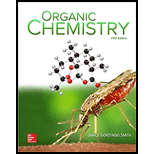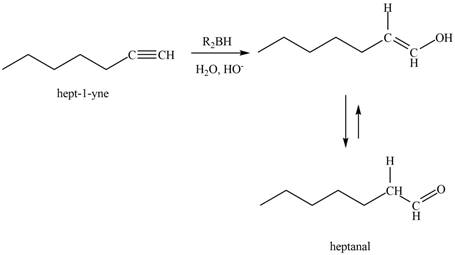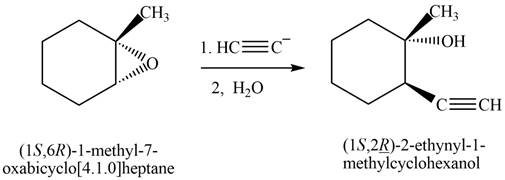
Concept explainers
Draw the organic products formed in each reaction.
a.  f.
f. 
b.  h.
h. 
d.  i.
i. 
e.  j.
j. 
(a)
Interpretation: The product that is formed by the reaction is to be drawn.
Concept introduction: The addition of an electrophile to an alkyne is followed by Markovnikoff’s rule and anti-stereoselectivity.
The addition of a halogen to an alkyne chain leads to the formation of corresponding alkene or alkane. The reaction which includes the addition of bromine atoms to the alkyne chain is known as bromination. Bromination can be done by using the reagents like
Answer to Problem 11.38P
The product that is formed by the reaction is
Explanation of Solution
The reaction of

Figure 1
The reaction of
The product that is formed by the reaction is
(b)
Interpretation: The product that is formed by the reaction is to be drawn.
Concept introduction: The addition of an electrophile to an alkyne is followed by Markovnikoff’s rule and anti-stereoselectivity.
The addition of a halogen to an alkyne chain leads to the formation of corresponding alkene or alkane. The reaction which includes the addition of bromine atoms to the alkyne chain is known as bromination. Bromination can be done by using the reagents like
Answer to Problem 11.38P
The product that is formed by the reaction is
Explanation of Solution
The reaction of

Figure 2
The reaction of
The product that is formed by the reaction is
(c)
Interpretation: The product that is formed by the reaction is to be drawn.
Concept introduction: The addition of a halogen to an alkyne chain leads to the formation of corresponding alkene or alkane. The reaction which includes the addition of bromine atoms to the alkyne chain is known as bromination.
The replacement or substitution of one functional group with another different functional group in any chemical reaction is termed as substitution reaction. The nucleophilic reaction that consists of bimolecular as well as bond-making and bond-breaking steps is termed as
Answer to Problem 11.38P
The product that is formed by the reaction is
Explanation of Solution
The reaction of

Figure 3
The reaction of
The reaction of

Figure 4
The reaction of
The product that is formed by the reaction is
(d)
Interpretation: The product that is formed by the reaction is to be drawn.
Concept introduction: A stepwise procedure of transforming an alkyne into a carbonyl group is known hydroboration-oxidation reaction. In a hydroboration-oxidation reaction, a terminal alkyne reacts with
Answer to Problem 11.38P
The product that is formed by the reaction is heptanal.
Explanation of Solution
The reaction of

Figure 5
The reaction of
The product that is formed by the reaction is heptanal.
(e)
Interpretation: The product that is formed by the reaction is to be drawn.
Concept introduction: The replacement or substitution of one functional group with another different functional group in any chemical reaction is termed as substitution reaction. The nucleophilic reaction that consists of bimolecular as well as bond-making and bond-breaking steps is termed as
Answer to Problem 11.38P
The product that is formed by the reaction is deuteroacetylene.
Explanation of Solution
The reaction of

Figure 6
The reaction of
The product that is formed by the reaction is deuteroacetylene.
(f)
Interpretation: The product that is formed by the reaction is to be drawn.
Concept introduction: A terminal alkyne reacts with
Answer to Problem 11.38P
The product that is formed by the reaction is
Explanation of Solution
The reaction of

Figure 7
The reaction of
The product that is formed by the reaction is
(g)
Interpretation: The product that is formed by the reaction is to be drawn.
Concept introduction: The replacement or substitution of one functional group with another different functional group in any chemical reaction is termed as substitution reaction. The nucleophilic reaction that consists of bimolecular as well as bond-making and bond-breaking steps is termed as
Answer to Problem 11.38P
The product that is formed by the reaction is
Explanation of Solution
The reaction of

Figure 8
The reaction of
The product that is formed by the reaction is
(h)
Interpretation: The product that is formed by the reaction is to be drawn.
Concept introduction: The replacement or substitution of one functional group with another different functional group in any chemical reaction is termed as substitution reaction. The nucleophilic reaction that consists of bimolecular as well as bond-making and bond-breaking steps is termed as
Answer to Problem 11.38P
The product that is formed by the reaction is
Explanation of Solution
The reaction of

Figure 9
The reaction of
The product that is formed by the reaction is
(i)
Interpretation: The product that is formed by the reaction is to be drawn.
Concept introduction: The replacement or substitution of one functional group with another different functional group in any chemical reaction is termed as substitution reaction. The nucleophilic reaction that consists of bimolecular as well as bond-making and bond-breaking steps is termed as
Answer to Problem 11.38P
The product that is formed by the reaction is
Explanation of Solution
The reaction of

Figure 10
The reaction of
The product that is formed by the reaction is
(j)
Interpretation: The product that is formed by the reaction is to be drawn.
Concept introduction: The replacement or substitution of one functional group with another different functional group in any chemical reaction is termed as substitution reaction. The nucleophilic reaction that consists of bimolecular as well as bond-making and bond-breaking steps is termed as
Answer to Problem 11.38P
The product that is formed by the reaction is
Explanation of Solution
The reaction of ethynylbenzene with

Figure 11
The reaction of ethynylbenzene with
The reaction of

Figure 12
The reaction of
The product that is formed by the reaction is
Want to see more full solutions like this?
Chapter 11 Solutions
PKG ORGANIC CHEMISTRY
Additional Science Textbook Solutions
Brock Biology of Microorganisms (15th Edition)
Cosmic Perspective Fundamentals
Microbiology Fundamentals: A Clinical Approach
SEELEY'S ANATOMY+PHYSIOLOGY
General, Organic, and Biological Chemistry - 4th edition
- Draw the product of the following H action sequence. Ignore any inorganic byproducts formed. 1. (CH3CH2)2CuLi, THF 2. CH3Br Q Atoms, Bonds and Rings H Charges ㅁarrow_forwardPlease help me with this the problem is so confusingarrow_forward14 Question (1 point) Disiamylborane adds to a triple bond to give an alkenylborane. Upon oxidation with OH, H2O2, the alkenylborane will form an enol that tautomerizes to an aldehyde. In the first box below, draw the mechanism arrows for the reaction of disiamylborane with the alkyne, and in the last box draw the structure of the aldehyde. 4th attempt Feedback i > 3rd attempt OH, H2O2 i See Periodic Table See Hintarrow_forward
- answer with mechanisms and steps. handwritten please!arrow_forwardHello I need some help with Smartwork. For drawing structure B, I know the correct answer is CH₃B₂, but when I try to type it in, it keeps giving me CH₄BH₃ instead. Do you know how I should write it properly? Should I use a bond or something else?arrow_forwardTrue or false, chemistryarrow_forward
- answer thse questions with mechanisms and steps. handwritten please!arrow_forwardC app.aktiv.com Draw the product of the following reaction sequence. Ignore any inorganic byproducts formed. H O 1. (CH3CH2)2CuLi, THF 2. CH3Br Drawingarrow_forwardDraw the product of the following reaction sequence. Ignore any inorganic byproducts formed. H O 1. (CH3CH2)2CuLi, THF 2. CHзBr Drawingarrow_forward
 Chemistry for Today: General, Organic, and Bioche...ChemistryISBN:9781305960060Author:Spencer L. Seager, Michael R. Slabaugh, Maren S. HansenPublisher:Cengage Learning
Chemistry for Today: General, Organic, and Bioche...ChemistryISBN:9781305960060Author:Spencer L. Seager, Michael R. Slabaugh, Maren S. HansenPublisher:Cengage Learning
